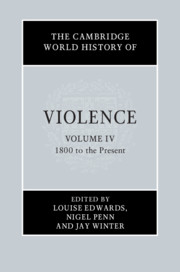Book contents
- The Cambridge World History of Violence
- The Cambridge History of Violence
- The Cambridge World History of Violence
- Copyright page
- Contents
- Figures and Maps
- Contributors to Volume IV
- Introduction to Volume IV
- Part I Race, Religion and Nationalism
- Part II Intimate and Gendered Violence
- Part III Warfare, Colonialism and Empire in the Modern World
- Part IV The State, Revolution and Social Change
- 17 Change and Continuity in Collective Violence in France, 1780–1880
- 18 Geographies of Genocide: The European Rimlands, 1912–1948
- 19 Concentration Camps
- 20 Violence in Revolutionary China, 1949–1963
- 21 Anti-Communist Violence in Indonesia, 1965–1966
- 22 The Violence of the Cold War
- 23 Quotidian Violence in the French Empire, 1890–1940
- 24 Violence, the State and Revolution in Latin America
- 25 Structural Violence during the Cambodian Genocide, 1975–1979
- 26 The Origins of Modern Terrorism
- Part V Representations and Constructions of Violence
- Index
- References
23 - Quotidian Violence in the French Empire, 1890–1940
from Part IV - The State, Revolution and Social Change
Published online by Cambridge University Press: 13 March 2020
- The Cambridge World History of Violence
- The Cambridge History of Violence
- The Cambridge World History of Violence
- Copyright page
- Contents
- Figures and Maps
- Contributors to Volume IV
- Introduction to Volume IV
- Part I Race, Religion and Nationalism
- Part II Intimate and Gendered Violence
- Part III Warfare, Colonialism and Empire in the Modern World
- Part IV The State, Revolution and Social Change
- 17 Change and Continuity in Collective Violence in France, 1780–1880
- 18 Geographies of Genocide: The European Rimlands, 1912–1948
- 19 Concentration Camps
- 20 Violence in Revolutionary China, 1949–1963
- 21 Anti-Communist Violence in Indonesia, 1965–1966
- 22 The Violence of the Cold War
- 23 Quotidian Violence in the French Empire, 1890–1940
- 24 Violence, the State and Revolution in Latin America
- 25 Structural Violence during the Cambodian Genocide, 1975–1979
- 26 The Origins of Modern Terrorism
- Part V Representations and Constructions of Violence
- Index
- References
Summary
Historians of violence in the French Empire have focused primarily on official agents of the state, such as soldiers, policemen, judges, and administrators. Violence perpetrated by non-state actors – that is, by European settlers, merchants, and travelers – remain far less explored in the historiography of French colonialism. In important ways, brutality perpetrated by non-state actors helped perpetuate the Manichean dynamics of colonialism so powerfully described by colonial and post-colonial critics alike. The prevalence of violence suggests that quotidian brutality was central to settlers’ sense of power and identity in regions where they felt under constant threat from larger non-European populations. This chapter examines how civilian mistreatment of colonial populations often differed starkly from the state’s efforts to legitimate its own use of violence in military, administrative, and judicial capacities. Indeed, such daily acts of violence were potentially threatening to the French power. They undermined administrative control of French citizens and destabilized what were often delicate balances of power between officials and subject populations. Equally important, uncontrolled violence jeopardized the central rhetorical claim that colonization brought rationalism and civilization to allegedly less-developed societies in Africa, Asia, and the Pacific.
Keywords
- Type
- Chapter
- Information
- The Cambridge World History of Violence , pp. 468 - 489Publisher: Cambridge University PressPrint publication year: 2020

